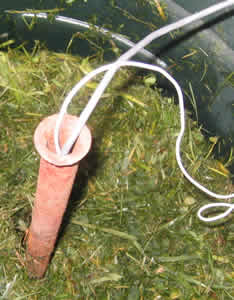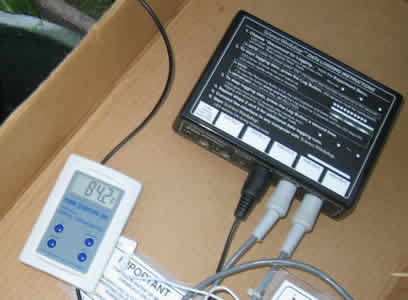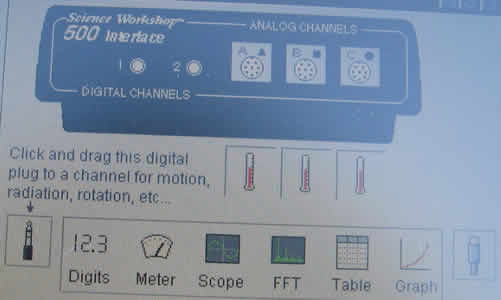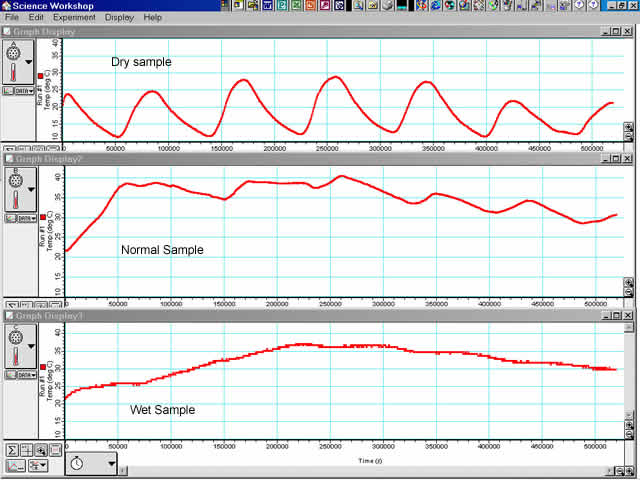The Effect of Moisture on Decomposition Temperature of Grass Clippings
SED 695B; Fall 2005
Research Question:
How is decomposition temperature affected by the moisture content of decaying grass clippings?

Standards addressed:
California Biology Standards
Ecology
6. Stability in an ecosystem is a balance between competing effects. As a basis for understanding this concept:
e.
Students know a vital part of an ecosystem is the stability of its producers and decomposers. f.
Students know at each link in a food web some energy is stored in newly made structures but much energy is dissipated into the environment as heat. This dissipation may be represented in an energy pyramid.
Applications:
- Composting is a very effective method of recycling organic waste material such as plant matter and cattle waste.
- Composting is being used for bioremediation of fuel oil spills.
- Grass clippings
- 3 trash cans
- 3 metal pipes 0.75 meters long by 2cm.
- Pasco model 500 interface
- 3 temperature sensors
- Digital thermometer with remote probe.
- plastic sheeting
- Distilled water


Here is the basic equipment. The three barrels must be placed in a location that is completely shady, but has good ventilation. This experiment doesn't smell particularly nice!
- Dry grass is placed in the barrel to the rear.
- Freshly cut grass is placed in the left front barrel.
- Freshly cut grass is also placed in the right front barrel and a gallon of distilled water sprinkled over the top evenly.

The interface is placed in a cardboard box lid and placed on top of the barrels.
The barrels will eventually be covered with plastic sheet to keep humidity in and away from the electronics.
Note that the interface can be disconnected from the computer to collect data independently. The interface can run on batteries, but I hooked it up to AC power for this week-long collection period.

The temperature probe is placed in a metal tube that penetrates the center of the mass of grass. All three barrels use this setup.
In this case, two probes go into the same tube, one from the interface, and one from a digital thermometer so that the process can be monitored without disturbing the interface.

The digital thermometer is placed in the same box with the interface.
You could do this experiment with three digital thermometers if you wish to record data manually.
You could also do without the digital thermometer simply by feeling the side of the barrels to note when the temperature drops toward ambient.

Hook the computer up to the interface, turn everything on, and bring up the Science Workshop software.
Drag a temperature sensor to all three of the analog channels.


Now the interface will be disconnected from the computer. Be sure to follow all the prompts. It would be really bad to run this experiment for a week and find out that the interface was programmed wrong!
After you get the interface programmed and ready, cover each barrel with sheet plastic and place some sort of weather shield over the whole works. You don't want the electronics rained upon!
A week passes by!

The last step is to connect the computer back up to the interface and retrieve the data.
As soon as you bring up the Science Workshop software the application will sense that the interface has stored data and will download the data. Here I have set up three graphs to show the data from the three sensors.

Here is the screen showing several days' data.
- The top graph shows the temperature of the dried grass sample.
This sample shows little biological activity. The ambient temperature swings are evident, as is the fact that the ambient temperatures in the middle of the week were somewhat higher than those on the weekends. - The second graph shows the temperature of the grass as cut.
This graph shows a rapid onset of decay activity, raising the temperature rapidly to the 35-40C range. The water content and heat input moderated the temperature swings in this container, but you can see some temperature swings that followed the ambient temperature toward the end of the data collection period. There was still enough decay activity at the end of the week to keep the temperature of this sample in the 30C range - The third graph shows the temperature of the grass with added moisture.
This sample shows a much slower temperature rise, probably due to the increased water content absorbing heat and keeping oxygen away from the decaying grass. The sample finally gets up to temperature on the second and third days and was still considerably above ambient temperature when the study was terminated.
Conclusion: Water is definitely required for the decay process to occur, but excess water delays both the onset and decline of the process. The thermal mass of the water also moderates the temperature of the sample, protecting it from wide swings in ambient temperature. These results confirm those of the Cornell University Compost Physics study referenced below.
References & Links:
Compost Physics from Cornell University.
Recycle.com's page on attaining correct compost temperature.
A source of dedicated compost thermometers.
A source of professional composting data loggers.
A study of diesel soil contamination remediation through composting